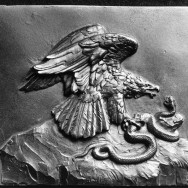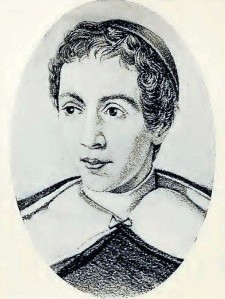Early historical associations of Sinsinawa–and what is the real meaning?
Posted in Sinsinawa Miscellany

The Wisconsin Historical Society’s Wisconsin Magazine of History, Volume 3, No. 3, March 1920, includes in its “Question Box” feature a Sister’s query, which you can read below. The Sinsinawa Dominicans have long held that Sinsinawa means “home of the young eagle”, and accordingly, Sinsinawa Mound’s St Clara Academy published a student periodical The Young Eagle in the late 19th and early 20th c. In the article below, the State Historical Society found a USGS record (which may be from around 1903), that indicates the meaning as “rattlesnake.” Mary Synon’s 1955 book Mother Emily of Sinsinawa says, “The name is either the Sac and Fox word meaning ‘clear water’, or the Siouan word for ‘home of the young eagle.'” The book Indian Place Names on Wisconsin’s Map states “home of the young eagle” and “rattlesnake” are said by different sources to be based on the word jinawe, which “is the Ojibwe word for rattlesnake in [Father Mazzuchelli’s friend and fellow Venerable, Bishop Frederick] Baraga’s dictionary, but it seems a poor match for Sinsinawa.” To make a long story short, we do not know exactly the meaning of Sinsinawa.
—
HISTORICAL ASSOCIATIONS OF SINSINAWA
I write to you today for information which is of vital interest to us at the present time. In March, 1918 among the Indian names given to ships by Mrs. Woodrow Wilson, “Sinainawa” attracted our attention. At our request and through the courtesy of an official of the United States Shipping board, Santa Clara College was accorded the honor of naming the sponsor for this ship. The Sinsinawa was intended for war service, but after the armistice the plans were changed to make it a cargo ship. The ship was built between January, 1919 and the present date and was sheduled to be launched on September 6, 1919. A member of our alumnae was appointed sponsor and had the honor of christening the vessel at the Hog Island shipyards on the date named. All of this has brought the name “Sinsinawa” very prominently to our interest and we are now desirous of celebrating the event in a particular way. For this reason I am interested in obtaining all the information which your records may be able to afford us; below I am enumerating under separate heads the details about which I should like to have special information.
I. A complete history of the name “Sinsinawa”
1. Whether name of a chief, maiden, or what.
2. The Indian dialect to which the name belongs.
3. The meaning in the Indian language.
4. Why applied to the mound which bears the name.
5. When first used.
II. Association of the name with events in the history of the territory of Wisconsin.
III. Association of the name with events in the history of the state of Wisconsin.
1. Association of the name with events in the history of Grant County.
IV. Date of establishing the post office bearing this name.
1. Names of persons responsible for the establishing of post office.
V. Local history of interest, if there is any.
VI. Names of citizens and legislators of the territory or state of Wisconsin associated in any way with the history of the place.
VII. If there are any Indian traditions or recorded historical facts relating to the place while this section of Wisconsin was still a part of Michigan, we should be glad to have whatever your files may contain.
Sister M. Clementine
Saint Clara College, Sinsinawa
The following report, taking up in order the several points noted in your inquiry concerning the history of Sinsinawa, has been prepared by Miss Kellogg of our research staff.:
I. Bulletin of United States Geographical Survey, No. 197, p. 239 gives the origin as “Sinsinawe,” meaning rattlesnake. It does not give the name of the tribe, but we incline to think it is a Sauk and Fox word. All the region around there was the Sauk and Fox mining ground. The mound took its name from the creek, and this name was first applied to the former by Gen. George Wallace Jones when in 1827 he leased a thousand acres containing the mound. The creek first appears upon a map of the lead mines drawn in 1829, it is there spelled “Sinsineua.” Se Wis. Hist. Colls., XI, 400. Other spellings are “Sinsinewa,” “Sinsinniwa,” and “Sinsinnawa.” General Jones states that the Indians accented the next to the last syllable.
II, III. During the early period of Wisconsin history Sinsinawa was known as the home of General Jones. The best authority on his career is Parish, Life of George Wallace Jones, Iowa Biographical Series. The Jones manuscripts belong to the Iowa Historical Society. You may secure additional information from them. The property you now possess passed directly from Jones to Father Mazzuchelli about 1844. The records of your institutions must supply the local history of the place in its later years.
IV. The first post office was established in 1835 when General Jones was territorial delegate from Michigan. He was himself postmaster and his emoluments were $1.92. In 1837 William P. Ruggles was postmaster. In 1839 no such post office was reported. In 1841 Charles Swift was postmaster, receiving 76 cents, with net proceeds $1.82. After that date there was no post office bearing the name Sinsinawa Mounds until 1857 when Thomas L. Powers was appointed postmaster and kept the place until 1865 when he was succeeded by O.S. Brady.
V, Vi, VII. The region of SInsinawa Creek is that of the earliest lead mining by the Indians that is known. Seeaccount in Wis. Hist. Colls., XIII, 271-92. Old Buck, the Indian who discovered the Buck lead, was living on Sinsinawa Creek in 1828. There is a local tradition that an American trader was killed at Sinsinawa during the War of 1812, probably on some branch of the creek. All of the Indians of this region were then in the British interest, and no “Long Knife,” as they called the Americans, was safe if his nationality was known. This tradition may thus probably be true. In 1832 a log fort was built at General Jones’s place, and there on June 19 three men working in a field without the fort were attacked by Indians and after a brief skirmish two of them were killed. The names are given differently by different authorities; some say John Thompson and James Boxley; others Lovell and Maxwell. It is possible all four were victims of the war, since one authority (Wis. Hist. Colls., X, 192) says four men lost their lives at Sinsinawa during the Black Hawk War.
General Jones is the only man of prominence, so far as we know, who lived at Sinsinawa. However, he had as visitors most of the prominent men of the territory. In his autobiography, published in Parish’s book, he tells of visits from Henry Dodge, the Gratiots, Jefferson Davis, and others.



